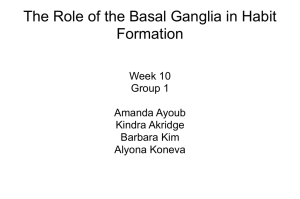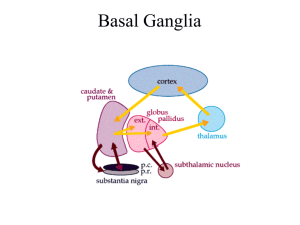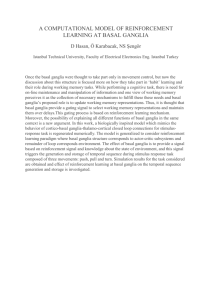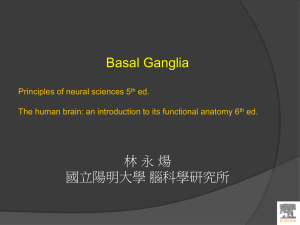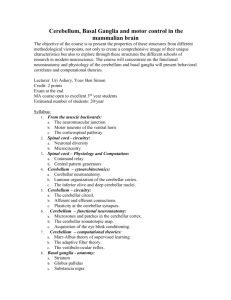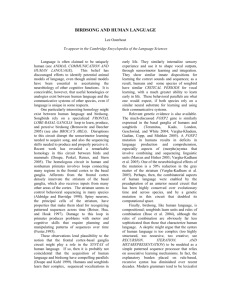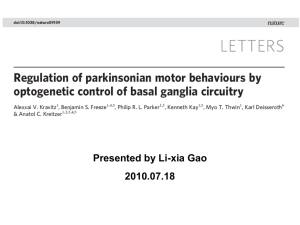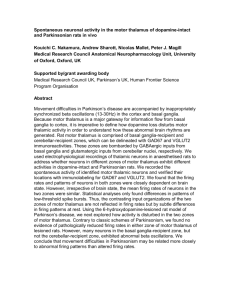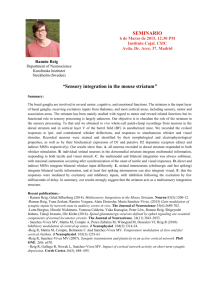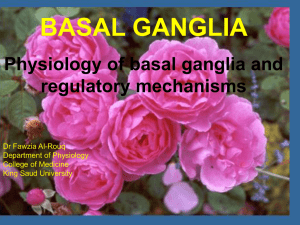basal ganglia
advertisement
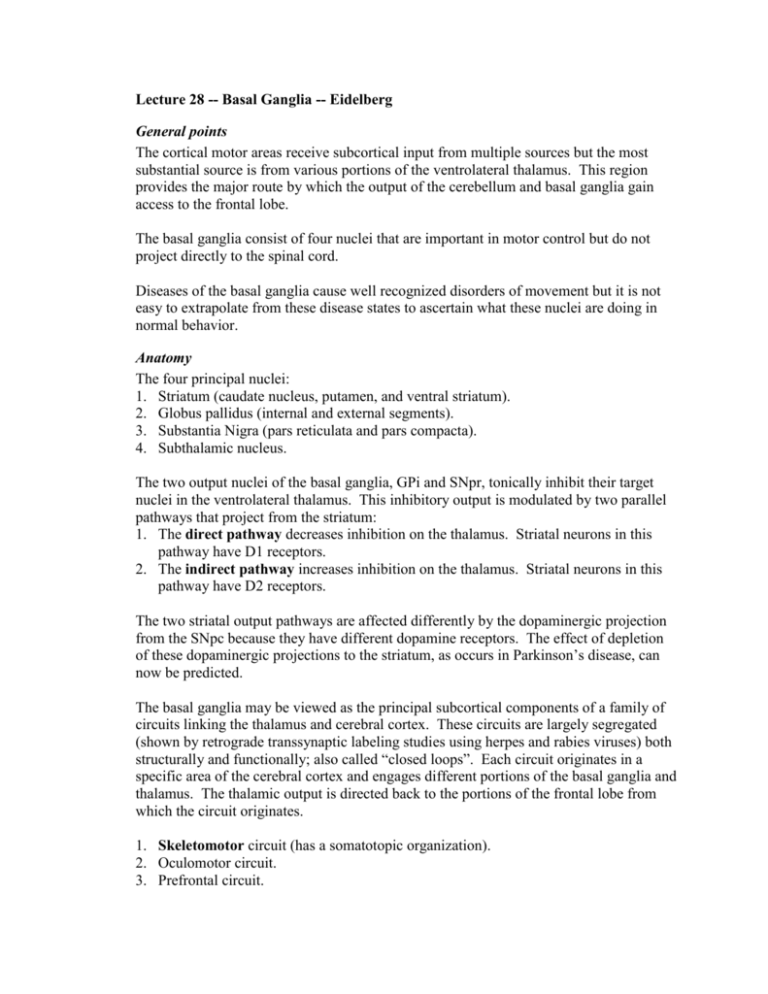
Lecture 28 -- Basal Ganglia -- Eidelberg General points The cortical motor areas receive subcortical input from multiple sources but the most substantial source is from various portions of the ventrolateral thalamus. This region provides the major route by which the output of the cerebellum and basal ganglia gain access to the frontal lobe. The basal ganglia consist of four nuclei that are important in motor control but do not project directly to the spinal cord. Diseases of the basal ganglia cause well recognized disorders of movement but it is not easy to extrapolate from these disease states to ascertain what these nuclei are doing in normal behavior. Anatomy The four principal nuclei: 1. Striatum (caudate nucleus, putamen, and ventral striatum). 2. Globus pallidus (internal and external segments). 3. Substantia Nigra (pars reticulata and pars compacta). 4. Subthalamic nucleus. The two output nuclei of the basal ganglia, GPi and SNpr, tonically inhibit their target nuclei in the ventrolateral thalamus. This inhibitory output is modulated by two parallel pathways that project from the striatum: 1. The direct pathway decreases inhibition on the thalamus. Striatal neurons in this pathway have D1 receptors. 2. The indirect pathway increases inhibition on the thalamus. Striatal neurons in this pathway have D2 receptors. The two striatal output pathways are affected differently by the dopaminergic projection from the SNpc because they have different dopamine receptors. The effect of depletion of these dopaminergic projections to the striatum, as occurs in Parkinson’s disease, can now be predicted. The basal ganglia may be viewed as the principal subcortical components of a family of circuits linking the thalamus and cerebral cortex. These circuits are largely segregated (shown by retrograde transsynaptic labeling studies using herpes and rabies viruses) both structurally and functionally; also called “closed loops”. Each circuit originates in a specific area of the cerebral cortex and engages different portions of the basal ganglia and thalamus. The thalamic output is directed back to the portions of the frontal lobe from which the circuit originates. 1. Skeletomotor circuit (has a somatotopic organization). 2. Oculomotor circuit. 3. Prefrontal circuit. 4. Limbic circuit. Physiology Single cell recording studies during rapid stimulus-triggered movements show that neurons fire in motor cortex before they fire in basal ganglia, suggesting serial processing. The basal ganglia may be helping select and focus neural activity associated with a desired movement (via direct pathway) and suppressing conflicting firing patterns associated with unwanted movements (indirect pathway). A substantial proportion of neurons in the skeletomotor circuit have directionallyselective neurons: - Neurons in GPi receiving input via striatum from supplementary motor area show setrelated activity. - Neurons in GPi receiving input via striatum from primary motor cortex exhibit phasic movement-related activity. These subpopulations suggest distinct subcircuits within the skeletomotor circuit and they each might have a distinct motor behavioral role. Note that this suggests that asking what the basal ganglia do in isolation is a poorly posed question, as they are integrated into specific behavioral loops. However, it may still be true that the basal ganglia are performing a similar computation in each loop. Movement Disorders Hypokinetic disorders, e.g. Parkinson’s disease with akinesia and bradykinesia. Hyperkinetic disorders, e.g. Huntington’s disease with dyskinesias: ballism, athetosis, and chorea. Overactivity in the Indirect Pathway is a major factor in Parkinsonian signs. - IV administration of L-DOPA causes dramatic but transient reversal of symptoms. - Patients begin to get fluctuations and dyskinesias after about 5 years of DOPA treatment. - MPTP-related PD led to explanatory model of PD: Loss of dopaminergic projection from SNpc leads to increased activity in the indirect pathway and decreased activity in the direct pathway because of the different actions of dopamine on D2 and D1 receptors respectively. - The opposite changes in the two pathways both lead to increased activity in GPi leading to increased inhibition of thalamocortical neurons and thus to hypokinesia. - Single cell recording in PD reveals increased activity in the subthalamic nucleus and GPi . Lesions of skeletomotor portions of subthalamus or GPi ameliorate symptoms of PD. - PET findings reveal losses in nigrostriatal dopamine function in early PD with progression of losses over the course of disease. - PET findings also show abnormal expression of metabolic brain networks in PD that can be reversed by treatment. Underactivity in the indirect pathway is a major factor in hyperkinetic disorders. The output of the GPi is reduced in hemiballism (violent involuntary throwing movements of the limb after a lesion in the contralateral subthalamic nucleus). Reduced inhibitory input to the ventrolateral thalamus may lead to excessive thalamocortical activity. Huntington Disease is an autosomal dominant hyperkinetic disorder characterized by: - Chorea, dementia and behavioral disturbance. - Early death of spiny neurons in striatum (specifically caudate) that give rise to indirect pathway: this may cause functional inactivation of subthalamic nucleus. - Gene defect on chromosome 4: codes for a cytoplasmic protein called Huntingtin. - First exon of gene contains CAG repeats encoding glutamine. Normally do not have more than 40 repeats. In HD have greater than 40 repeats. - Genetic anticipation: earlier onset of disease in offspring than in parent due to expansion of repeats. - The pattern of cell loss seen in HD resembles that caused by glutamate toxicity seen in rat striatum injected with NMDA agonists. - PET studies have shown loss of D2 receptors and glucose metabolism in the striatum of HD patients and asymptomatic gene carriers. This reflects the specific loss of D2bearing projection neurons from the striatum to the external pallidum, which is typical of HD. Drug-induced dyskinesias due to DOPA therapy for PD c.f. chorea in HD: excessive dopaminergic inhibition of striatal projection to GPe leading to inhibition of STN leading to decreased inhibitory output from GPi. Cognitive Roles of the Basal Ganglia. The closed cortico-subcortical loops, other than the skeletomotor, involve prefrontal and limbic areas and play roles in motivation, emotional arousal and executive function: 1. Dorsolateral prefrontal circuit - loss of executive functions and tasks requiring working memory. Frontal dysfunction may indirectly impair memory (verbal/nonverbal) and visuospatial performance as evidenced on neuropsychological tests. To a lesser degree attentional functions may be impaired. Language is generally intact. 2. Lateral orbitofrontal circuit - impulsivity, obsessive-compulsive disorder, Tourette’s Syndrome. 3. Anterior cingulate circuit - apathy, akinetic mutism. Relevant reading: chapter 43 in “Principles”
